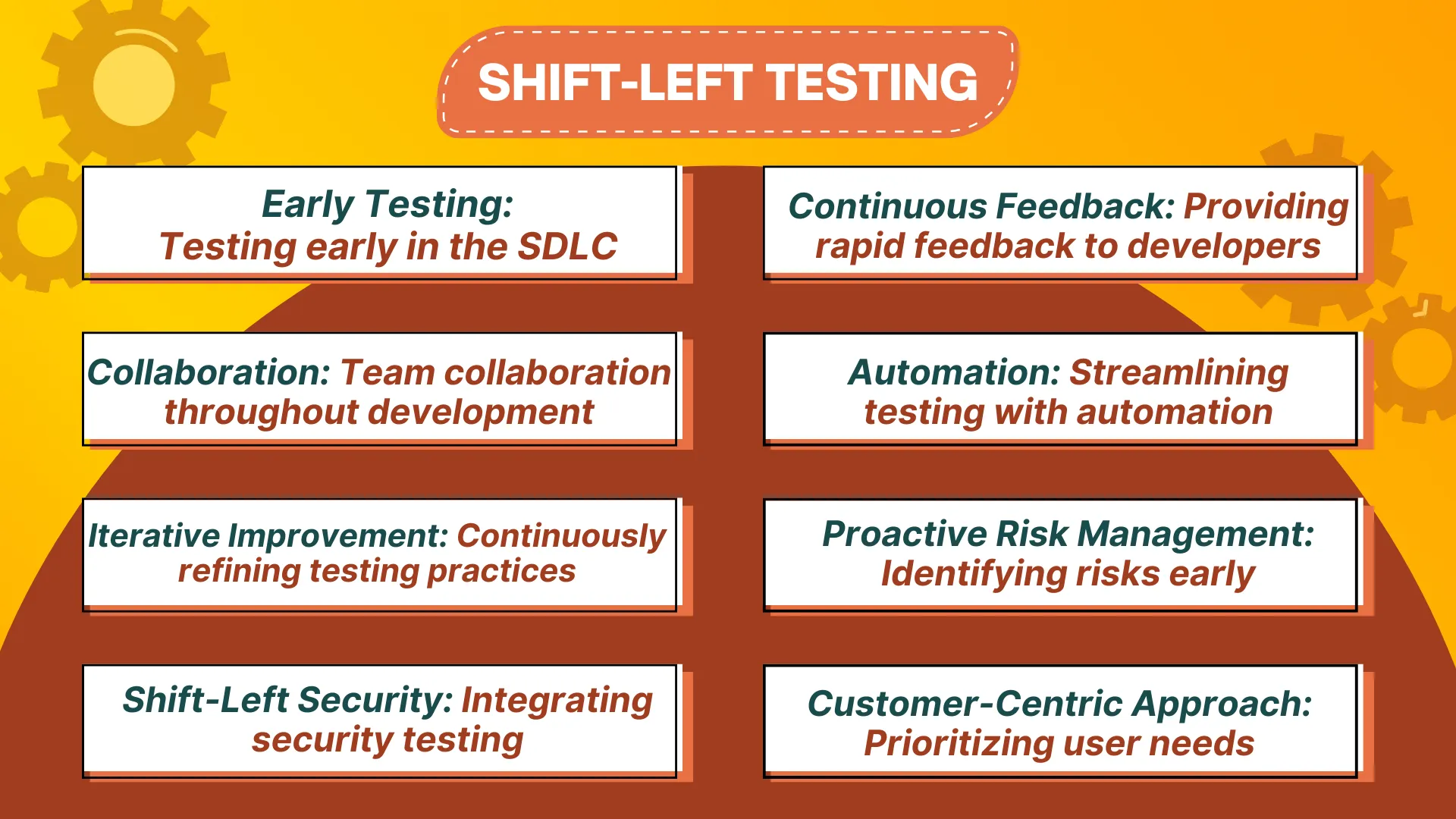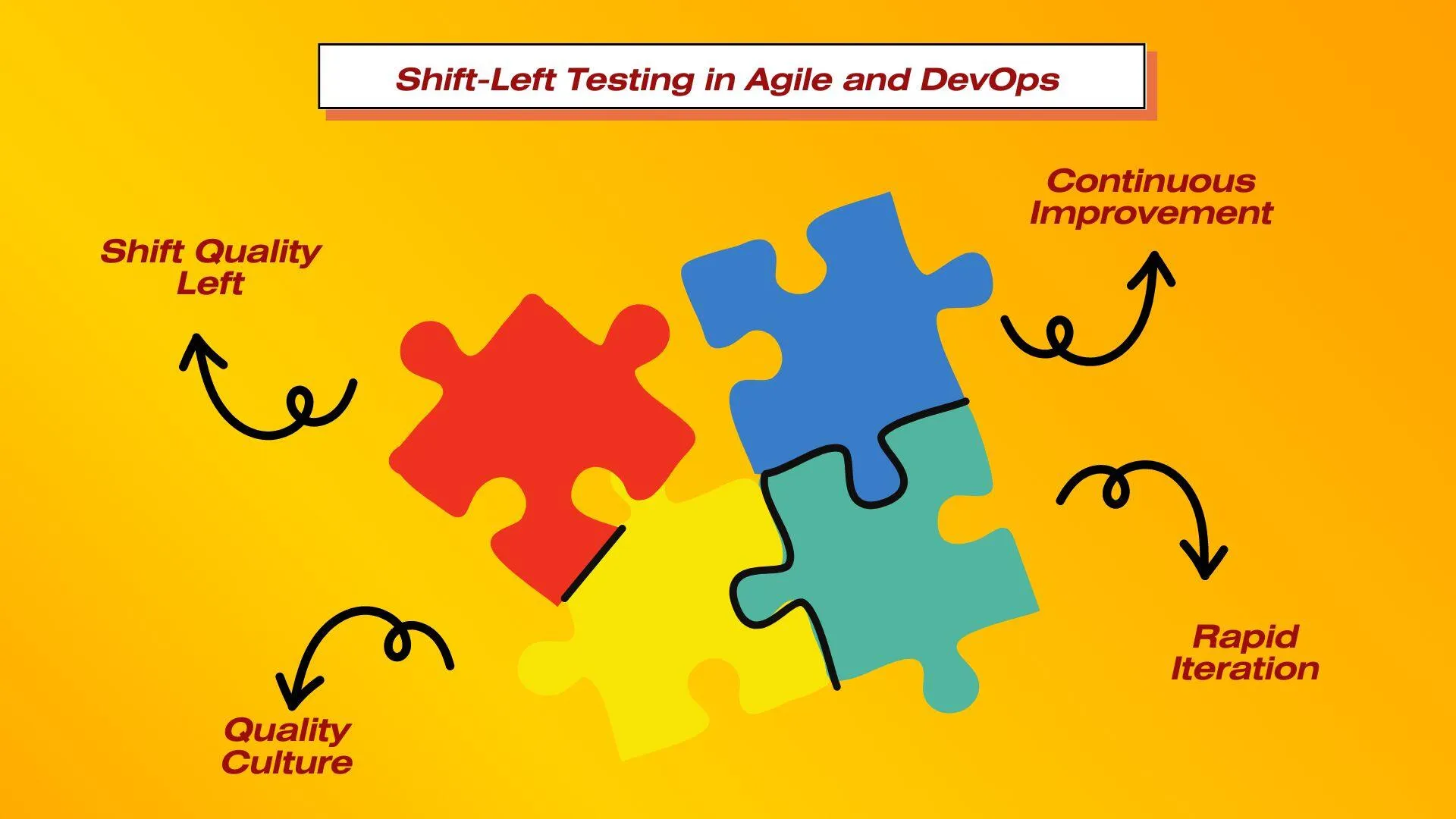In today's fast-paced software development landscape, the need for early detection of bugs and faster deployment cycles is more critical than ever. Shift-left testing has emerged as a key strategy to achieve these goals, particularly in Agile and DevOps environments.
By moving testing processes earlier in the development lifecycle, organizations can uncover issues sooner, leading to quicker resolution and ultimately delivering higher-quality software to end-users. 🚀
📌 Shift-Left Testing Overview: Conduct testing early in the software development lifecycle for faster fixes and improved quality.
📌 Key Principles of Shift-Left Testing: Early testing, continuous feedback, collaboration, automation, and iterative improvement.
📌 Benefits of Shift-Left Testing: Faster feedback, reduced costs, improved quality, increased efficiency, and enhanced collaboration.
📌 Challenges of Implementing Shift-Left Testing: Cultural resistance, skillset requirements, tooling integration complexities, and resource constraints.
📌 Shift-Left Testing Trends: AI advancements, security testing focus, increased performance testing in CI/CD, and emphasis on collaboration and improvement.

What is Shift-Left Testing?
Shift-left testing is a methodology that emphasizes the importance of conducting testing activities early in the software development lifecycle (SDLC), ideally as soon as possible after the code is written. The shift-left approach aims to catch defects and issues closer to their point of origin, typically within the development phase rather than waiting until later stages, such as system testing or user acceptance testing.
By identifying and addressing issues early on, teams can minimize the cost and effort required to fix them, ultimately reducing the time to market for new features and enhancements. 🕑

What Are the Key Principles of Shift-Left Testing?
Several key principles guide shift-left testing:
- Early Testing: Conducting testing activities as early as feasible in the SDLC.
- Continuous Feedback: Providing rapid and continuous feedback to developers about the quality of their code.
- Collaboration: Fostering collaboration between developers, testers, and other stakeholders throughout the development process.
- Automation: Leveraging automation tools and user acceptance testing to streamline testing processes and increase efficiency.
- Iterative Improvement: Continuously refining testing practices based on feedback and lessons learned from previous cycles.
- Proactive Risk Management: Identifying and mitigating potential risks early in the development process to prevent issues from escalating.
- Shift-Left Security: Integrating security testing practices early on to identify vulnerabilities and ensure the robustness of the software.
- Customer-Centric Approach: Prioritizing the needs and preferences of end-users throughout the development lifecycle to deliver solutions that meet their expectations.🔄

Why Shift-Left Testing Is Important in Agile and DevOps Environments?
In Agile and DevOps methodologies, where rapid iteration and deployment are paramount, shift-left testing plays a crucial role in ensuring that software meets quality standards while keeping pace with the accelerated development cycles.
By integrating testing into the development workflow from the outset, teams can detect and address issues early, reducing the risk of defects slipping through to later stages of the SDLC.
This proactive approach not only improves the overall quality of the software but also enhances team collaboration and efficiency by fostering a culture of shared responsibility for quality. 🔍

Here Are Some Common Shift-Left Testing Techniques.
- Unit Testing: Developers write automated unit tests to verify individual components or modules of the software in isolation.
- Integration Testing: Testing the interaction between different modules or subsystems to ensure they function correctly when integrated.
- Static Code Analysis: Using tools to analyze source code for potential defects, security vulnerabilities, and adherence to coding standards.
- Peer Reviews: Conducting code reviews among team members to identify issues and provide feedback early in the development process.
- Early Exploratory Testing: Exploring the application's functionality and user experience to uncover potential issues before formal testing begins.🧪
- Continuous Integration Testing: Automates testing every time code is integrated, ensuring new changes don't break existing functionality.
- API Testing: Validates application programming interfaces (APIs) for functionality, reliability, performance, and security.
- Regression testing: Re-tests modified code to ensure existing functionality remains intact after changes are made.
- End-to-end Testing: Test automation frameworks such as Cypress, Selenium, or Appium play a pivotal role in end-to-end testing by automating the simulation of user interactions. These frameworks enable efficient testing across multiple layers of the application stack, detecting potential issues and ensuring seamless integration of all components.
- Load and Performance Testing: Evaluate system performance under various load conditions to identify bottlenecks and optimize performance. 🔄

What Tools and Technologies Are Best Suited for Shift-Left Testing in Agile and DevOps?
Several tools and technologies support shift-left testing initiatives in Agile and DevOps environments:
- Continuous Integration (CI) Servers: Tools like Jenkins, Travis CI, and CircleCI automate the process of building, testing, and deploying software whenever changes are made to the codebase.
- Test Automation Frameworks: Frameworks such as Selenium, Appium, and JUnit enable teams to automate tests for web applications, mobile apps, and APIs.
- Code Analysis Tools: Static analysis tools like SonarQube and Checkmarx help identify code quality issues, security vulnerabilities, and compliance violations.
- Collaboration Platforms: Platforms like Jira, Trello, and Slack facilitate communication and collaboration among team members, including developers, testers, and product owners.
- Containerization and Orchestration: Technologies like Docker and Kubernetes provide infrastructure automation and scalability, enabling faster and more efficient testing in containerized environments. 🧰
- Continuous Testing Tools: Platforms like TestComplete, Ranorex, and Sauce Labs enable continuous testing across various platforms and environments.
- Integration with CI/CD Tools: Ensure seamless integration with CI/CD tools like Jenkins, GitLab CI, or GitHub Actions to automate testing processes within the development pipeline.
- Version Control System Compatibility: Support for integration with version control systems such as Git or SVN to manage test scripts and ensure version control across the testing environment.
- Security Testing Tools: Solutions like OWASP ZAP, Burp Suite, and Acunetix facilitate security testing by identifying vulnerabilities and ensuring compliance with security standards.
- Performance Monitoring Tools: Platforms such as Dynatrace, Datadog, and Grafana offer performance monitoring capabilities, allowing teams to track system performance and identify optimization opportunities.

What Are the Key Differences Between Traditional Testing and Shift-Left Testing in Agile Environments?
Traditional testing approaches often involve waiting until later stages of the SDLC, such as system testing or user acceptance testing, to begin testing activities. In contrast, shift-left testing advocates for testing to occur much earlier in the development process, ideally as soon as code is written. This fundamental difference results in several key distinctions:
- Timing: Traditional testing occurs later in the SDLC, while shift-left testing occurs earlier, often alongside development activities.
- Scope: Traditional testing typically focuses on verifying the entire system's functionality, while shift-left testing emphasizes testing individual components or features as they are developed.
- Feedback Loop: Shift-left testing provides rapid feedback to developers, enabling them to address issues sooner, whereas traditional testing may result in longer feedback cycles and delayed bug fixes.
- Responsibility: In shift-left testing, developers and testers share responsibility for ensuring software quality, whereas traditional testing may be seen as primarily the testers' responsibility. 🔄

What Are the Benefits of Incorporating Shift-Left Testing into the CI/CD Pipeline?
Integrating shift-left testing into the Continuous Integration/Continuous Deployment (CI/CD) pipeline offers several advantages:
- Faster Feedback: By automating tests and running them as part of the CI/CD process, teams receive rapid feedback on the quality of each code change, enabling them to address issues sooner.
- Reduced Costs: Catching and fixing defects early in the development process is less expensive than addressing them later, when they may have already propagated to other parts of the system.
- Improved Quality: Shift-left testing helps maintain a higher level of software quality by identifying and addressing issues early, leading to more stable and reliable releases.
- Increased Efficiency: Automating repetitive testing tasks frees up time for testers to focus on more complex scenarios and exploratory testing, improving overall testing efficiency. 📈

The Advantages of Shift-Left Testing in CI/CD Pipelines.
In CI/CD pipelines, shift-left testing offers several advantages:
- Continuous Testing: Shift-left testing ensures that testing occurs continuously throughout the development process, from code check-in to deployment, rather than waiting until the end of the cycle.
- Immediate Feedback: Test results are available immediately after each code change, allowing developers to address issues promptly before they escalate.
- Enhanced Visibility: Shift-left testing provides visibility into the quality of each build and release, enabling teams to make informed decisions about whether to proceed with deployment.
- Risk Reduction: By catching defects early and consistently, shift-left testing reduces the risk of introducing bugs into production environments, thereby enhancing overall system stability. 🚦

What Are the Biggest Challenges to Implementing Shift-Left Testing in Agile and DevOps Teams?
Despite its numerous benefits, implementing shift-left testing in Agile and DevOps teams can pose challenges:
- Cultural Resistance: Shifting testing activities earlier in the development process requires a cultural shift within organizations, which may encounter resistance from team members accustomed to traditional testing approaches.
- Skillset Requirements: Adopting shift-left testing may necessitate upskilling or reskilling team members to effectively utilize new tools and methodologies.
- Tooling Integration: Integrating shift-left testing tools and processes into existing CI/CD pipelines and development workflows can be complex and time-consuming
- Resource Constraints: Limited resources, such as time, budget, and expertise, may hinder organizations' ability to fully implement shift-left testing practices. 🛠️

Overcoming the Top Challenges in Agile and DevOps Shift-Left Testing in 2024.
To overcome the challenges of implementing shift-left testing in Agile and DevOps teams, organizations can take several proactive steps:
- Education and Training: Invest in training programs and workshops to educate team members about the benefits and best practices of shift-left testing.
- Collaborative Culture: Foster a culture of collaboration and shared responsibility for quality across development, testing, and operations teams.
- Tool Selection and Integration: Evaluate and select tools that align with the organization's goals and integrate seamlessly into existing CI/CD pipelines.
- Continuous Improvement: Embrace a mindset of continuous improvement, regularly reviewing and refining shift-left testing processes based on feedback and lessons learned. 📚

In What Ways Does Shift-Left Testing Improve Overall Software Quality in Agile and DevOps Projects?
Shift-left testing contributes to overall software quality in Agile and DevOps projects in several ways:
- Early Defect Detection: By identifying and addressing issues early in the development process, shift-left testing helps prevent defects from propagating to later stages, resulting in higher-quality software.
- Consistent Feedback Loop: Continuous testing and feedback throughout the SDLC enable teams to iteratively improve software quality and address issues promptly.
- Improved Collaboration: By encouraging interaction among engineers, testers, and different stakeholders, shift-left testing improves communication and creates a common understanding of quality objectives.
- Improved Customer Satisfaction: Delivering high-quality software more frequently and reliably enhances customer satisfaction and loyalty, driving business success. 🌟

The Role of Shift-Left Testing in Agile and DevOps Environments on Software Quality.
In Agile and DevOps environments, shift-left testing plays a pivotal role in ensuring software quality by:
- Shifting Quality Left: By integrating testing earlier in the development process, shift-left testing helps prevent defects from reaching downstream stages, ultimately reducing rework and improving overall quality.
- Enabling Continuous Improvement: Continuous testing and feedback loops enable teams to identify areas for improvement and implement corrective actions iteratively, leading to enhanced software quality over time.
- Supporting Rapid Iteration: Shift-left testing facilitates rapid iteration and experimentation, allowing teams to quickly validate assumptions, incorporate user feedback, and deliver value to customers more frequently.
- Building Quality In: By making quality everyone's responsibility and integrating testing into the development workflow, shift-left testing fosters a culture of quality throughout the organization. 🏗️

How can Shift-Left Testing be adapted for different types of Software Projects?
While the core principles of shift-left testing remain consistent across different types of software projects, specific implementation strategies may vary based on factors such as technology stack, development methodology, and target platforms.
Here are some considerations for adapting shift-left testing to different types of projects:
📍Web Applications:
- Prioritize cross-browser and cross-device compatibility testing to ensure a consistent user experience across various platforms.
- Leverage tools like Selenium WebDriver for automated browser testing and frameworks like React Testing Library for unit and integration testing of frontend components.
📍Mobile Apps:
- Invest in mobile testing frameworks such as Appium or XCTest for automated testing across multiple device types and operating systems.
- Pay special attention to performance testing and usability testing, given the unique constraints and user interactions associated with mobile devices.
📍APIs:
- Implement contract testing to verify the interactions between different microservices or API endpoints, ensuring compatibility and reliability.
- Use tools like Postman or Insomnia for API testing, including functional testing, load testing, and security testing.
📍Embedded Systems:
- Incorporate hardware-in-the-loop (HIL) testing and simulation tools to validate the interaction between software and physical devices.
- Employ techniques such as boundary value analysis and equivalence partitioning to test inputs and outputs within defined ranges.

What changes can be added to Shift-Left Testing to fit different software projects?
To adapt shift-left testing to fit different software projects, teams can consider implementing the following changes and enhancements:
📍Customized Test Strategies: Tailor testing strategies to align with the specific requirements, constraints, and risks associated with each project, whether it's a web application, mobile app, or embedded system.
📍Flexible Tooling: Select testing tools and technologies that are well-suited to the project's technology stack, development methodology, and target platforms, ensuring compatibility and ease of integration.
📍Scalable Automation: Design automated test suites that can scale with the project's complexity and growth, enabling teams to maintain high test coverage and efficiency over time.
📍Continuous Learning: Encourage a culture of continuous learning and experimentation, where teams regularly evaluate and adapt their testing practices based on feedback, industry trends, and emerging technologies.
How can we measure the success of a Shift-Left Testing Strategy?
Measuring the success of a shift-left testing strategy requires defining clear and relevant metrics that align with the organization's quality goals and objectives. Some key metrics to consider include:
- Defect Detection Rate: Measure the percentage of defects identified during early testing stages compared to later stages, such as system testing or production.
- Cycle Time: Track the time it takes to identify, fix, and retest defects, aiming for shorter cycle times to accelerate feedback loops and delivery cycles.
- Test Coverage: Assess the percentage of code or functionality covered by automated tests, striving for comprehensive coverage to mitigate risk and improve confidence in releases.
- Customer Satisfaction: Solicit feedback from end-users and stakeholders to gauge satisfaction with the quality and reliability of the software, using surveys, reviews, and support tickets as indicators.
- Mean Time to Detect (MTTD) and Mean Time to Resolve (MTTR): Calculate the average time it takes to detect and resolve defects, aiming to minimize these metrics to enhance responsiveness and agility.

Latest Trends in Shift-Left Strategies for Agile and DevOps.
As organizations continue to adopt Agile and DevOps practices, several trends are shaping the evolution of shift-left testing strategies:
AI and Machine Learning: Leveraging artificial intelligence (AI) and machine learning (ML) technologies to augment testing efforts, including predictive analytics, anomaly detection, and test case generation.
Shift-Left Security Testing: Integrating security testing practices earlier in the development process to identify and mitigate vulnerabilities before they can be exploited by attackers.
Chaos Engineering: Embracing chaos engineering principles to proactively test and validate system resilience, including failure injection, fault tolerance, and recovery mechanisms.
Shift-Left Performance Testing: Incorporating performance testing into the CI/CD pipeline to assess application scalability, responsiveness, and resource utilization under various load conditions.
Shift-Left Compliance Testing: Ensuring regulatory compliance by embedding compliance testing activities into the development workflow, addressing privacy, accessibility, and data protection requirements.
People also ask
👉🏻 How Does Shift-Left Testing Contribute to Faster Delivery in Agile and DevOps?
Shift-left testing accelerates delivery by catching defects early, reducing rework and enabling faster feedback loops between development and testing.
👉🏻Why Does Shift-Left Testing Matter in CI/CD?
Shift-left testing is integral to CI/CD pipelines, ensuring that each code change undergoes rigorous testing before deployment, thus maintaining the pipeline's reliability and efficiency.
👉🏻How Can Developers and Testers Collaborate Effectively in Shift-Left Testing?
Effective collaboration between developers and testers requires clear communication, shared ownership of quality, and leveraging collaborative tools and techniques to integrate testing seamlessly into the development process.
👉🏻What Role Does Automation Play in Shift-Left Testing?
Automation is central to shift-left testing, enabling teams to execute tests quickly and consistently, achieve higher test coverage, and free up human testers to focus on more complex and creative testing tasks.
👉🏻When to Follow Shift-Left Testing?
Shift-left testing should be followed from the outset of the development process, continuing iteratively throughout the SDLC to maximize its benefits and impact on software quality. 🔄





%201.webp)

